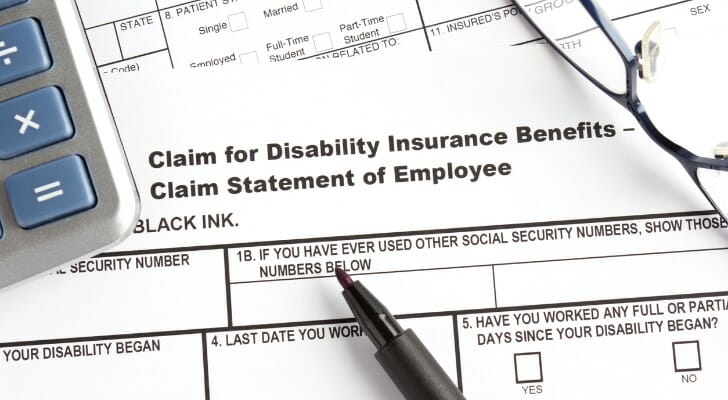 Adding riders to a life insurance policy can make your coverage more comprehensive. A disability income rider can provide you with a steady source of income if you become disabled and can no longer work. Disability riders are a type of living benefit, as you’re drawing money from the policy during your lifetime. Including this type of rider may work in your favor if you’re concerned about a disability preventing you from supporting your household financially. Use SmartAsset’s matching tool to find an experienced financial advisor who can help you assess and meet your insurance needs.
Adding riders to a life insurance policy can make your coverage more comprehensive. A disability income rider can provide you with a steady source of income if you become disabled and can no longer work. Disability riders are a type of living benefit, as you’re drawing money from the policy during your lifetime. Including this type of rider may work in your favor if you’re concerned about a disability preventing you from supporting your household financially. Use SmartAsset’s matching tool to find an experienced financial advisor who can help you assess and meet your insurance needs.
What Is a Life Insurance Disability Income Rider?
A disability income rider is an addition to a life insurance policy that provides financial protection in the event that the policy owner becomes disabled. If you can’t work because of a total and permanent disability, the policy can pay out supplementary income benefits to you. Those benefits can be used to pay medical expenses or everyday living expenses.
The rider may also include a waiver of premium provision that allows you to waive your premium payments in the event of a disability. Your policy still remains in effect, as if you were paying the premiums. If you’re able to return to work, then you’d resume making your regular premiums. This is a nice benefit to have as it can help you to avoid losing the policy altogether.
How a Life Insurance Disability Income Rider Works
A disability income rider for life insurance works by providing you with a source of income if you’re unable to work because of a disability. The amount you’re able to draw from a disability income rider depends on the terms of the policy. It’s common for insurers to pay 1% to 2% of the policy’s face value in income. So if you have a $1 million life insurance policy then you might be able to receive $10,000 per month in benefits.
There may or may not be limits on how much you can receive in disability income over your lifetime or how long payments will continue. The waiver of premiums if you become disabled may be included in your rider or you may need to purchase a separate rider for that. With a waiver of premium, you can typically only take advantage of this benefit up to a certain age. For example, this benefit might end at age 60.
Whether you’ll pay for a disability income rider or a separate waiver of premium rider can depend on the insurance company. Some insurers offer certain types of disability riders for no additional cost while others tack on an extra fee to your premiums. But generally, any additional cost is usually less than what you might pay to purchase a separate disability insurance policy.
Pros and Cons of a Disability Income Rider
 Disability income riders can provide you with current income if you become disabled. That income could be a financial lifeline if you’re the sole provider for your household. If you have a cash value policy, then your cash value could continue to accumulate. And if your policy allows for a waiver of premiums while you’re disabled, this can provide further financial relief.
Disability income riders can provide you with current income if you become disabled. That income could be a financial lifeline if you’re the sole provider for your household. If you have a cash value policy, then your cash value could continue to accumulate. And if your policy allows for a waiver of premiums while you’re disabled, this can provide further financial relief.
There are, of course, some stipulations that go along with adding a disability income rider to a life insurance policy.
First, your insurance company may have certain requirements you need to meet in order to prove your disability status. You may need to be diagnosed with a permanent disability or disabling health condition by a licensed physician or doctor. Along with a professional diagnosis, the life insurance company will likely request documentation showing that your disability is permanent.
If you’re already receiving Social Security disability payments, you may be able to use this as proof. But it’s important to consider how receiving supplemental income benefits from your life insurance policy may affect your ability to continue receiving Social Security disability benefits. Receiving disability benefits over a certain threshold can reduce the amount you’re eligible to get from Social Security.
Aside from those requirements, there may be a waiting period before you can begin drawing income benefits from your policy. You might need to wait six months to a year, for instance, before you can file a disability claim and receive benefits. That means it may be a good idea to ensure that you have adequate savings or investments you can use to cover expenses in the interim.
There may also be certain exclusions for what’s covered and what’s not with regard to different types of disabilities or how those disabilities are caused. Talking to a licensed insurance agent or your financial advisor can help you weigh the pros and cons of adding a disability income rider to your life insurance policy.
Who Needs a Life Insurance Disability Income Rider?
Whether it makes sense to have a disability income rider for life insurance can depend on how likely you are to become disabled and how much you have available in other financial resources to replace lost income. If you’re concerned that you might be unable to work because of a disability then it could make sense to accept a slightly higher premium in order to add this coverage.
On the other hand, you may decide to forego this type of rider if you already have a short- or long-term disability insurance policy or you have sufficient savings to replace lost income. You may also opt out of a disability income rider if you think your odds of becoming totally and permanently disabled are relatively low.
If you’re considering a disability income rider, be aware that you may need to add this on at the time you purchase a life insurance policy. You may not be able to add it to an existing policy after the fact. Also, take time to compare rates for life insurance and disability income riders to find the best policy for you at the most affordable cost.
The Bottom Line
 Including a disability income rider for life insurance could give you peace of mind if you’re worried about being able to provide for your family because you have a disability. Along with this rider, consider what other types of riders you may need or want to include in your life insurance coverage, such as a guaranteed insurability rider or a cost of living rider.
Including a disability income rider for life insurance could give you peace of mind if you’re worried about being able to provide for your family because you have a disability. Along with this rider, consider what other types of riders you may need or want to include in your life insurance coverage, such as a guaranteed insurability rider or a cost of living rider.
Insurance Planning Tips
- Consider talking to a financial advisor about disability income riders and other additions to life insurance. Finding a qualified financial advisor doesn’t have to be hard. SmartAsset’s free tool matches you with up to three financial advisors who serve your area, and you can interview your advisor matches at no cost to decide which one is right for you. If you’re ready to find an advisor who can help you achieve your financial goals, get started now.
- Use SmartAsset’s no-cost insurance calculator to determine how much protection is appropriate for you.
- If you’re buying life insurance for the first time it can be helpful to use a life insurance calculator to estimate how much coverage you might need. You can also compare quotes for life insurance online to find the best rates. Remember that the younger you are and the healthier you are when buying life insurance, the lower your premiums are likely to be.
Photo credit: ©iStock.com/urbazon, ©iStock.com/olm26250, ©iStock.com/numbeos